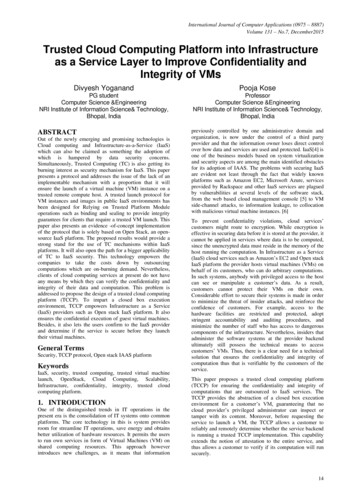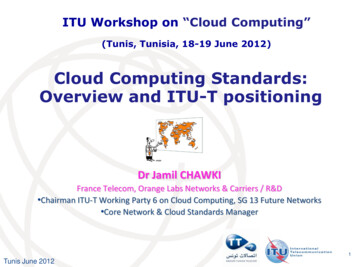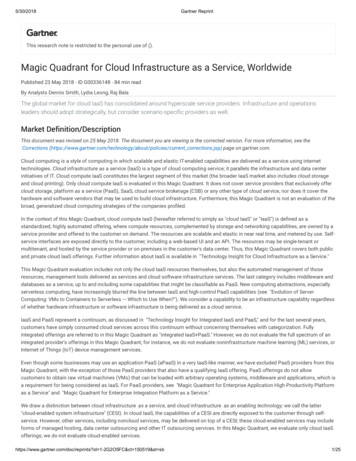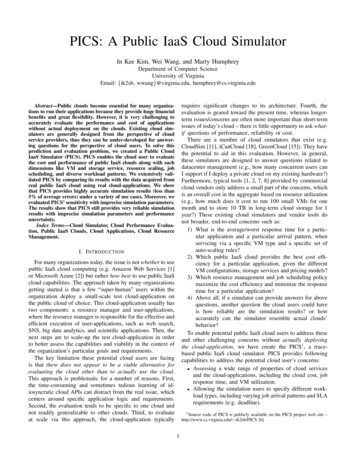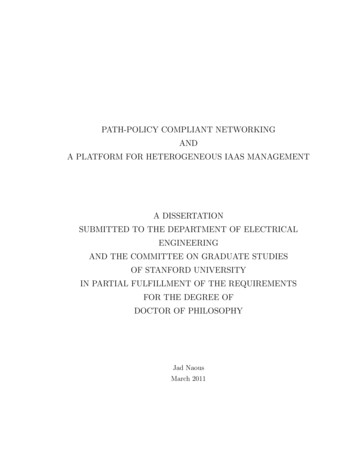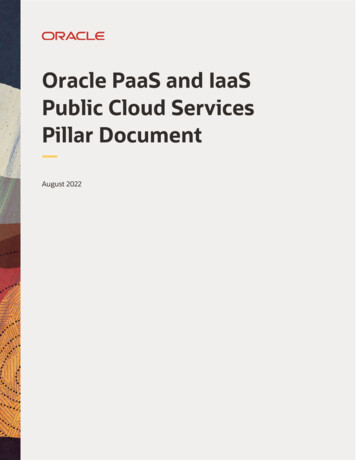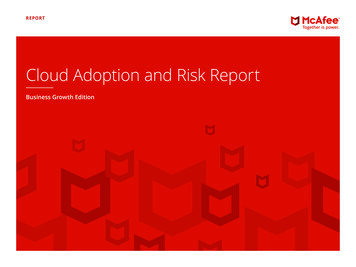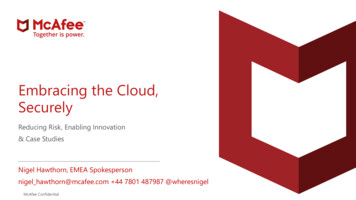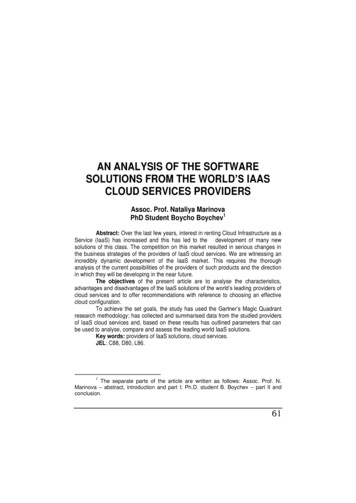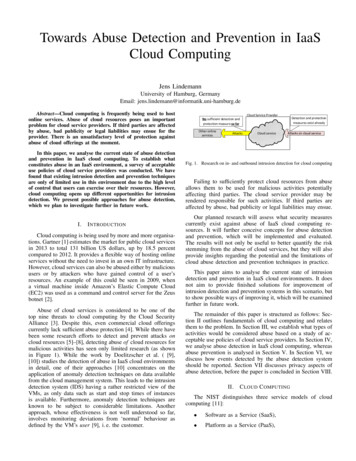
Transcription
Cloud IaaS in Portugal - A Go To Market StudyNuno BajancaLisbon Tech, PortugalEmail: nunobajanca@tecnico.ulisboa.ptAbstract—Cloud Computing services are replacing traditionalInformation Technology (IT), with Vendors and Enterprisesshifting its investments to cloud infrastructures. Even thoughthis is the global pace, there is no concrete knowledge on thesolutions available in the Portuguese market.This thesis, produced with Dimension Data (DD) collaboration,presents a report on the Infrastructure as a Service (IaaS)solutions advertised in the Portuguese Market, and an applicationdesigned and deployed in the DD public cloud.The report consists of an analysis of several IaaS featuresthat differentiate cloud solutions. These features were determinedbased on references in the analysis of the world market andreviewed during interviews with the solutions’ vendors. The Application (App) is a follow-up of in-house-developed applicationsbut is the first to adopt a cloud-based approach. It is used bytwo thousand DD’s employees on a daily basis.The results obtained show that there isn’t a single cloudsolution that fits all use cases, with vendors stronger for cloudnative applications and others providing a resilient infrastructurefor general business applications. Using a benchmark tool on theApplication, it was observed that the proposed cloud architectureis significantly faster than the non-cloud approach.Within Dimension Data, the work presented enabled its salesteam to understand the Portuguese market, by positioning thecloud solutions evaluated according to their use case. The application also empowered DD’s operations team with knowledge ontheir cloud offer and ground work for an internal shift to cloudenvironments.I. I NTRODUCTIONCloud Computing adoption is rising each year, with International Data Corporation (IDC) estimating a growth of 44,2%in the next 24 months [1]. Furthermore, RightScale reportedthat 95% of the companies interviewed for their 2016 reportare leveraging IaaS [2].This demand for cloud services has been shifting the ITinvestment from infrastructure to the provider site and externalclouds making the major IT providers and vendors enter thecloud market.One example is Dimension Data (DD), a South Africaninformation technology services company founded in 1983and solely owned by NTT [3]. Dimension Data acquired acompany known by its Software as a Service (SaaS) offer inorder to enter the cloud market. Its IaaS offer, released in2012, led DD to be one of the fifteen vendors considered inGartner’s IaaS 2015 Worldwide Magic Quadrant [4].Although this is the global panorama, in Portugal, one ofthe fifty-eight countries with local offices, Dimension Datadidn’t have in the begging of 2016 a concrete knowledge onthe solutions being presented to national companies nor hadteams dedicated and prepared to sell its own, or others1 , IaaSsolutions to its clients.This fact, combined with a rising number of Portugueseclients, including the public administration, looking to investin cloud solutions created a need to analyze the cloud solutionssold in Portugal. Besides this analysis, there was also a needto learn and understand DD’s advantages and features.To position DD (and its partners) in perspective with theremaining market, a report [5] analyzing twenty cloud solutions, by eleven companies was produced in the context of thisthesis. To write this report, the companies were contacted withthe objective of clarifying their solutions in terms of Compute,Storage, Network, Service Level Agreement (SLA), and otherrelevant subjects.The report is available, as a working paper, in DD collaboration applications, and was presented to the PortuguesePre-Sales and Sales Teams. Additionally, since most solutionssold in Portugal are the ones sold in Europe, this report is apowerful tool for all the European teams.To attain knowledge on DD technical infrastructure andoffers a cloud-native application was designed and deployed inits Public Cloud. The application, named Dashboards, is usedto enable performance management to all the DD Portugalemployees that are involved with the response to BusinessOpportunities, namely the Pre-Sales, Sales, Operations andBack-Office Departments.This document starts by related work, followed by a briefdigest of the report. Moreover, there is a high-level examination of the application and in the end, there is a section onconclusions and future work.II. R ELATED W ORKThis section starts with the study of Dimension Data (DD)cloud solution, providing a non-generic research into featuresthat differentiate each cloud use case. After that there is a research on cloud market reports, to infer on report methodologyand identify the top vendors.A. Dimension Data’s CloudDD IaaS offer [6], [7] is sold in two different deploymentmodels: Public Cloud - Provisioned for open use by the generalpublic and exists on the premises of the cloud provider.The DD offer is called Compute as a Service (CaaS) andis available in the five inhabited continents.1 DD besides having its own solution is an Integrator, selling also its partnerssolutions.
Private Cloud - Cloud infrastructure provisioned for exclusive use by a single organization comprising multipleconsumers. Private Cloud may exist off or on-premisesand so two solutions are available:– Hosted/ Dedicated Cloud - The Compute and Storageresources, usually rented by the rack, are provisionedin the public cloud Data Centers (DCs) for a singlecompany.– Off-premises - Installed in the client DC, this solution is called Private Cloud Enterprise Edition(PCEE) and consists of converged infrastructure(Vblock System from VCE [8]) configured to DDspecifications.According to National Institute of Standards and Technology (NIST) [9], there are two deployment models remaining,being them Community Cloud and Hybrid Cloud. CommunityCloud is a Private Cloud that is provisioned for severalorganizations that share the same concerns, and DD sells itby offering a white-label version of its orchestration UserInterface (UI). Hybrid cloud is the combination of two or moredistinct cloud infrastructures, that remain unique identities butare bound together to enable data and application portability.If an enterprise uses both Public and Private Cloud then it isalready working with Hybrid Cloud.Besides having to compete with similar offers, that will bepresented in section III, DD also has to be aware of cloudalternative. The three other services that allow enterprises torun their workloads in remote servers are Dedicated Servers,Virtual Private Servers (VPSs) and Colocation Centers [10].In cloud computing the service depends on the ability ofthe vendor to provide on-demand elastic resources provisionedover the network, and all of this needs to be measured throughtop-level metrics To define the exact conditions, both functional and non-functional, under which services are deliveredcompanies need SLAs [11].Dimension Data SLA for IaaS cloud, considered a goodreference by Gartner’s analyst Lydia Leong [12], providesUptime (availability), Response time (latency), Capacity capability indicators, Support and Reversibility and terminationprocess Service Level Objectives (SLOs). However, this oneof the few SLAs in the market that follows the Europeanguidelines [13]. The lack of consistency in this area createdthe need for a standardization, that is currently being drafted(ISO/IEC 19086 [14]).DD IaaS solutions support a wide range of applications,with the company advertising: i) productivity (Microsoft Exchange, Skype for Business and SharePoint), ii) collaborationtools (video, web conferencing, messaging and integratedunified collaboration solutions) , iii) Enterprise Resource Planning (ERP) (SAP and Oracle), iv) custom in-house developedapplications and v) environments for development, testing,staging and preproduction.According to Gartner [15], the first three supported application mentioned above clearly refer to the general businessapplications use case. For this use case, the following featurescategories are expected: Compute resilience - referring to Virtual Machine (VM)availability, due to its importance for non-cloud architectures that used to assume that the hypervisor wouldassure their resilience;Architecture flexibility - because cloud environmentsneed to be versatile and assure that the consumer maydesign the architecture to his need;Security and compliance - ranging from security controlsto governance, being one of the major concerns for themajority of the consumers [2].Hybrid IT - referring to enterprise integration, to assurethat the cloud environment is easily used alongside thelegacy environment.Backup and Disaster Recovery - not consider by Gartnerbut contemplated in this document, for being essential andtransversal to any system that requires business continuity[16].Besides general business applications, important use casesfor cloud environments are application development (fifthsupported application), batch computing and cloud-nativeapplications (fourth supported application). Therefore, usermanagement, automation and DevOps enablement, scaling andbig data enablement categories are also pertinent for these usecases.In the following sections, DD solutions will be analyzedregarding the main resources associated with cloud computing[17] (Compute, Storage, and Network), followed by a globalresearch on features that don’t apply to any of these resources.1) Compute: The resource responsible for provisioning andmanaging virtual machines requested by the users [18]. DDassures compute resilience with VM auto-restart, anti-affinityrules, and live migration. Live migration [19] assures that theinstance is preserved during host maintenance, by enabling thetransference of VMs between distinct physical nodes withoutstopping the running tasks. Affinity rules are also seen as aresilience feature but DD doesn’t include them in its offers.CaaS and PCEE have non-fixed-size and realizable VMsup to 32 virtual CPU (vCPU) and 256 GB RAM. To assurea higher architecture flexibility, PCEE enables, through negotiation, the use of non-virtualized machines, and CaaS hastwo vCPU speed tiers. On the other hand, CaaS doesn’t allowsingle tenant hosts, that are the basis of on-demand PrivateCloud [20] and are usually offered in Public Cloud solutionsthat lack a private cloud complement.Focused on the enterprise market, DD provides import andexport of custom VM images as well as VM deployment fromsnapshots. Although not being CaaS use case, by allowinglarge VMs, it enables big data. The only lacking feature, interms of compute and for big data, is Graphics Processing Unit(GPU) on-demand capabilities.2) Storage: From the three storage services available in thecloud (File, Block, and Object), DD, in its European DCs, onlyoffers Block Storage. However, three performance tiers areavailable and storage volumes are VM independent assuring adecent architecture flexibility.
To assure data portability, relevant for Hybrid IT, there is thepossibility to import or export data on physical media [21]. DDdoesn’t offer any Content Delivery Network (CDN) integrationfor storage, yet offering CDN for Object Storage is a goodenabler of scalability.Furthermore, Object Storage by itself is an enabler of bigdata, with objects abstraction providing advantages of both fileand block storage but with better flexibility and abstraction[22]. Nevertheless, the only DCs hosting Cloud Files (DD’sObject Storage solution) are located in North America.3) Network: Assures that decoupled, highly scaled, andrapidly changing collections of service components can beprovisioned and hooked together on-demand [23], being at thecore of cloud computing.Architecture flexibility is provided by the ability to create,in a self-service manner, complex hierarchical topologies(multiple networks, multiple IP addresses per VM) and thesupport of static IP assignment.Request for Comments (RFC) 1918 [24] defines the addressallocations for private networks, and by allowing the clients tochose a private IP address from those set, DD ensures hybridIT. Furthermore, clients may also extend the enterprise WideArea Network (WAN) to the cloud environment in a secureand dedicated connection [25].Finally, and for scaling purposes, there is the requirementfor load balancing services that are assured in its traditionalform (Front and Back-end) in all the offers. Global load balancing, referring to the distribution of incoming traffic acrossDCs in different regions, is accomplished by Domain NameServer (DNS) [26] not being available in DD’s solutions.4) Remaining Cloud Features: DD has several security features, namely Access Control List (ACL), Intrusion DetectionSystem (IDS), Intrusion Prevention System (IPS), Multi-FactorAuthentication (MFA), self-service firewall and DistributedDenial-of-Service (DDoS) mitigation. Additionally, audit logs,that record all the actions performed in the cloud environment,are created and DD’s employees can’t login into clients VMsunless managed services are acquired.Alongside these features, there is the use of techniques likeoverwriting the storage before reallocating it and sanitizingphysical media before disposal [27]. Moreover, and to assurecompliance, the following certifications are available: ISO/IEC 27001 [28] - Best-known standard providingrequirements for an Information Security ManagementSystem (ISMS);SOC 2 [29] - Report on controls at a service organization relevant to security, availability, processing integrity,confidentiality, or privacy;PCI DSS - Composed by a set of requirements assuringthat the cardholder data (stored, processed or transmittedby merchants and processors) is secured [30].Other interesting certification, not available in DD cloudsystems, are SOC 1 [29], relevant to a user entity’s internalcontrol over financial reporting, and HIPAA BAA [31], thatenables a company to receive protected health informationfrom a health care provider. However, DD has the capabilityto help its clients obtain the HIPAA BAA certification.To enable user management the features available are RoleBased Access Control (RBAC) and integration with Microsoft(MS) Active Directory (AD). However, the possibility to definequotas and billing alerts is lacking from DD’s solutions.DevOps [32] is a conceptual framework to address thedevelopment and operations departments collaboration. It leadsto the automation of the process of software delivery and isenabled by the offer of relational Data Bases (DBs), NoSQLDBs and caching in an as-a-service approach. DD has a smallmarket place and so for this purpose there is a python packagewith capabilities to launch several products (DBs and more) ina pre-composed series of Application Programming Interface(API) commands.The pre-composed series of API commands referred aboveare done through definition files, being this capability calledInfrastructure as code[33]. To remove the lock-in factor, allowing multi-cloud deployments, DD supports Apache LibCloud[34]. Other well known multi-cloud orchestrators are ApachejClouds and Fog but these are not supported.Very important in the Scaling category are auto-scalingcapabilities. PCEE and CaaS both have horizontal and vertical static auto-scaling capabilities, triggered by thresholdbased rules. Vertical auto-scaling refers to the provision ofmore/fewer resources for a particular VM, whereas, horizontalauto-scaling refers to the addition/removal of VMs from aload-balancing pool [35]. This service is static because VMsare powered on/off instead of created/destroyed (dynamicapproach).Lastly, we have Backup and Disaster Recovery (DR) features that are critical for businesses. These may range fromfairly simple off-site storage solutions to fairly complex realtime replication systems [36]. The feature available in thiscategory is complete backup (with options for retention period and backup windows) that may cover the on-premisesinfrastructure and use a secondary site. DR is handled as amanaged service by DD.B. Cloud ReportsCloud Reports are documents that bring a qualitative analyze of the cloud market, allowing the comprehension of itsevolution. The solutions that are enabling this transformationand how clients are leveraging them are also part of somereports.These solutions comparisons are very relevant for decisionmaking and were used in this document, both to gatherinformation on cloud vendors, as well as to understand whatis considered critical in a cloud solution.The two reports analyzed were Gartner’s Magic Quadrantfor Cloud IaaS (Worldwide) [4] and The Forrester Wave forPrivate Cloud Software Suite [37].The Magic Quadrant is produced by applying on eachsolution provider a set of evaluation criteria that helps asserthow their solutions perform against Gartners market view.Interviews are also carried out and therefor, not only is the
solution evaluated (Ability to execute) but also the strategy(Completeness of vision).Forrester analysis, similarly to Gartner’s, is done based onthe weight of the current offer, alongside with the vendor strategy. The Forrester Wave also evaluates the market presence,by representing each vendor with a size representative bubble.III. E NTERPRISE C LOUD I AA S REPORTThe lack of reports on the Portuguese Cloud IaaS market,together with the need to empower Dimension Datas salesteam with the knowledge to sell its offers, created the demandfor the report examined in this section.Firstly, there is an overview of the Methodology applied tothe production of the report, followed by a summary of all theresults obtained. Moreover, the conclusions of the report willalso be summarized.A. MethodologyThe fundamental pieces of this report were defined at thebeginning of the investigation, being in order: i) which vendorswould be selected, ii) how would the information be obtainedand iii) which features would be considered in the comparison.To select the vendors four characteristics were consideredmandatory: Portuguese Market Participation - The vendor shouldbe present in the Portuguese market, either directly orthrough partners and resellers. Portuguese Market Revelation - The vendor should beleading in it relevant segments2 . Relevant Business Capabilities - The vendor should beready for the enterprise market, being able to invoice andnegotiate customized contracts and have a 24/7 customersupport (including phone support). Relevant Technical Capabilities - The vendor must besuitable to support production workloads, both enterprise,and cloud-native. This needs to be based on successfulimplementations, not necessarily in the Portuguese Market.Having the previous requirements at hand, the Gartner andForrester reports presented in section II-B were used to selectthe vendors to be analyzed in the report.After excluding the vendors that didn’t have workforcesassign to Portugal and the ones that lack market participation, the following remained: Amazon Web Services, CiscoSystems, Dimension Data, Fujitsu, Hewlett Packard Enterprise(HPE), International Business Machines (IBM) Corporation,Microsoft, and VMware. Due to the fact that Claranet, OVH,and PT Empresas are relevant to the Portuguese and Europeanmarket they were also analyzed.The vendors considered were contacted in May, with anexplanation of the study being conducted. The objective atthis time was to gather contacts that could be later on used tocorroborate the information discovered and to bring togetherinsights related to the solutions.2 Due to a lack of market studies in this field the Dimension Datas estimatedmarket share (perception) was used as a reference.In July, with the layout and information to be addressedalready defined, the contacts gathered were contacted with anonline form, pre-filed with information available online. Theobjective, successful in some cases, was for the employees tocorroborate the data gathered online, filling the empty fieldswith the information related to the pertinent feature.It was possible, from this contact, to schedule some meetings that brought not only a better understanding of thevendor’s solution but also insight on the view of the Portuguese Cloud Market. These meetings took place in Ciscoand Fujitsu with its Portuguese cloud engineers. Besidesthese two vendors, DD, IBM and OVH also responded tothe form. Furthermore, Dimension Data offer was learnedthrough internal tutoring and a video conference meeting witha Solution Architect.Non-responding cloud vendors were introduced in the report when a search in their documentation, together with ananalysis of recent reports, was enough to respond to the form.B. Report summaryThe report [5], with 125 pages, starts with a short introduction on Cloud IaaS followed by a chapter on evaluatedsolutions. Further in the report chapters on Compute, Storage,Network, Backup, Security, Management and DevOps wereadded, followed by a pricing analysis of the Public Cloudsolutions. Finally, a Conclusions chapter pointing the solutionsmore adequate for each use case was used to sum up.The chapter approach explained above will be followed inthis document with chapters being replaced by sections andthe introduction being left out.1) Vendor Solutions: In this first section some commentsregarding geographic availability, vendor services, hypervisors,hybrid cloud readiness and SLAs were introduced.The solutions that are the focus of this study are presentedin table I. The ones evaluated in terms of features were underlined, contrarily to those that don’t have enough informationonline and whose vendors didn’t participate in this study.OpenStack [38], an open source cloud operating systemsupported by more than five hundred companies, is featuredon the table being the Cloud Operating System (OS) used byMetapod, k5, BlueBox and OVH Public Cloud.Geographic Availability: Most providers (vendors withhosted solutions) have two or more DCs in every inhabitedcontinent, with the exception of Africa, but only Fujitsu (CaaSoffer) and PT Empresas allow to host workloads in Portugal.DD is the only with DCs in Africa and Claranet and OVHonly cover Europe.Vendor Services: While AWS, Azure and OVH follow a doit-yourself approach, the other vendors have an all-managedstrategy (with several managed services available and even IToutsourcing). This is observed even in the software solutionsanalyzed (Cisco Metapod and Fujitsu k5 on-premises), thatare both sold with 24/7 monitoring provided by the vendor.DD and HPE private offers differentiate from others installedon-premises for being available in a renting model (OperatingExpenditure (OPEX)).
TABLE IC LOUD SOLUTIONS OF THE VENDORS SELECTED . U NDERLINED OFFERSWERE STUDIED AT THE FEATURE LEVEL .VendorsAWSCiscoClaranetHPEHostedIntegrated----One rivatePublicCaaS-IBMk5 ayerBlueBox-MicrosoftAzure--Azure teServers--VMware---vRealizeSuiteHypervisors: VMware is unquestionably the one compatiblewith most solutions (10 out of 17). KVM, native OpenStackhypervisor, is the second, being compatible with 6 solutions,followed by Hyper-V, available in five.Hybrid Cloud Readiness: Hybrid Cloud is leverage throughthe integration of public and private solutions sold by the samevendor but only Fujitsu and DD use the same UI for both.Although HPE doesn’t have a public cloud solution it presentsout-of-the-box integration with AWS to assure Hybrid Cloud.The other approach, available in Cisco, Dimension Data,Fujitsu, and IBM, is to use multi-cloud orchestrators to assurethat their offers are integrable with AWS, Azure, and otherclouds. These orchestrators, e.g.: Cisco CloudCenter and IBMCloud Orchestrator, allow the client to connect several privateand public clouds and manage them in a centralized manner.In regard to SLAs the only available SLO was server uptimewith an average of 99,95%, translating in almost twentytwo minutes of unavailability per month. Multi-fault-domains,referring to the need to assure that the workload doesnt dependon a unique availability zone3 , are only required by AWS andAzure.The other controversial point is reimbursement, varyingfrom one hundred percent to less than thirty percent of themonthly bill. The negotiation of the SLA is only possible inFujitsu and OVH.2) Compute: In terms of Compute Resilience mostproviders assure VM auto-restart capabilities, Anti-Affinityrules, and VM preserving during maintenance. IBM SoftLayer3 Availability zone definition varies from providers to provider but is usuallyused to describe a sector of a DC where network and electricity are shared.is the exception being incapable of assuring any of thecapabilities mentioned above.Regarding architecture flexibility most public cloud solutions use a tiered offer for VMs, limiting the number of CPUto RAM ratios. This lack of flexibility becomes more evidentin offers with few tears and is in some providers accompaniedby the impossibility to resize a VM without re-provisioning it.DD and IBM received a positive spotlight on this field withrealizable and non-tiered offers.Although, single-tenant hosts are usual in public cloudoffers, they aren’t requested by many clients in the solutionswithout them. On the other hand, bare-metal servers are onlycommon in private clouds.All offers analyzed have strong enterprise integration capabilities, allowing the deploy from snapshots and the importand export of VM images. The same doesn’t apply to big dataenablement, with AWS and Azure being the only offers withaccess to GPUs and large VMs sizes.3) Storage: Object storage is a constant in almost everysolution analyzed. In contrast, File storage is available in lessthan half. Additionally, most vendors have at least three Blockstorage performance tiers in public cloud and two in private,assuring a proper architecture flexibility. For this reason, it’simportant to refer that AWS, IBM SoftLayer, and Azure arethe only offers that support every storage type and have threeor more tiers for block.Other relevant remarks regarding architecture flexibility are: SSD storage is uncommon; All solutions have VM-Independent storage; The capability to connect multiple VMs to the samestorage volume is unusual; Almost half of the offers analyzed allow to resize astorage volume.In terms of scalability only AWS, IBM SoftLayer and Azureoffer CDN together with its storage. On the other hand, mostvendors allow import and export of data in physical media,potentiating Hybrid IT.4) Network: In terms of architecture flexibility all solutionsallow the creation of complex hierarchical network topologies.Regarding enterprise integration all providers allow the connection of their network to the client outside the internet andmost offers give clients the ability to extend the enterpriseWAN.Load balancing is available in all solutions and in the hostedoffers global load-balancing is also commonly available.5) Backup: Backup is assured by all providers, but AWSand OVH Public Cloud dont have complete backup solutions,being only capable of saving snapshots. Trough the analysisof the offers it was also possible to conclude that the providersthat offer complete backup also assure that this backup can bereplicated to a secondary site.Also relevant, is the possibility to backup on-premisesmachines to the cloud environment, only assured by DD,SoftLayer, and Azure. Lastly, in terms of Disaster Recoverystrategies it was possible to conclude that Managed Serviceswith this objective are offered by most vendors.
6) Security: It was observed that MFA, ACL, and DDoSmitigation are offered in most solutions and that IDS/IPS anda self-service firewall are also offered in more than 60% ofthe solutions.Regarding compliance it was possible to conclude thatISO 27001, SOC 2 and PCI DSS are almost assured by allproviders, followed by SOC 1. Only OVH Public Cloud lacksin terms of compliance, but during the response to this study,it was denoted that these four certifications are in road-map.Regarding user management, most offers are integrable withAD and offer RBAC. However, there is a tendency for lessgranular RBACs in OpenStack, that natively only has fourroles.7) Management: Looking at the offers analyzed it waspossible to conclude that only OpenStack allows the definitionof Quotas. However, with the objective of assuring a propermanagement most solutions allow the creation of billing alerts.In terms of scaling, it was observed that horizontal autoscaling is offered by most vendors, usually in a dynamicfashion. Hybrid IT related to management was a downsidefor the majority of the offers due to the lack of softwaremarketplaces. AWS and Azure differentiate from others inthis area with several software companies selling productsexclusively for these clouds.Monitoring and continuous availability of the control planeare assured by most vendors, enabling DevOps and Automation. On the other hand, Service Catalogs are not common.8) DevOps: One of the ways to enable DevOps is byoffering Relational and NoSQL DBs as well as in-memorycaching services in a self-service manner. While AWS, Azure,and IBM SoftLayer offer these services natively, almost allvendors have options from integration with Platform as aService (PaaS) services to open-source libraries. The sameapplies for Hadoop services, enabling Big Data.Application lifecycle management (ALM) is supported byfew vendors, but infrastructure as code is available in most offers. In terms of multiple-provider libraries, Apache LibCloudis very well positioned with almost all solutions supportingthis library. jClouds and Fog seem less relevant with fewersupporters.9) Pricing: In this chapter of the report only the PublicCloud solutions were analyzed4 and all data is accurate asof May 10, 2016. The fast changing offers and prices makethis section accurate for a short time but its conclusionsnonetheless rel
clouds making the major IT providers and vendors enter the cloud market. One example is Dimension Data (DD), a South African . Gartner's IaaS 2015 Worldwide Magic Quadrant [4]. Although this is the global panorama, in Portugal, one of . and identify the top vendors. A. Dimension Data's Cloud DD IaaS offer [6], [7] is sold in two .
